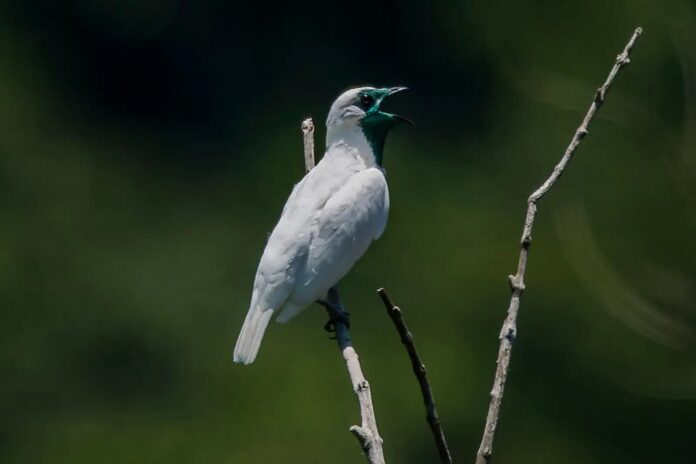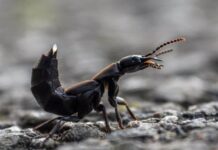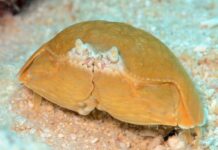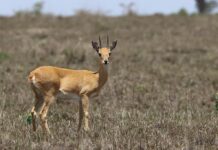Bellbird is one of the birds with the loudest call, and the males have some interesting features that you might find fascinating. Hearing one of them while trekking can be quite traumatizing, but they are absolutely harmless. There are 4 bellbird species, so let’s see if they are the birds that you are familiar with.
1Bare-Throated Bellbird
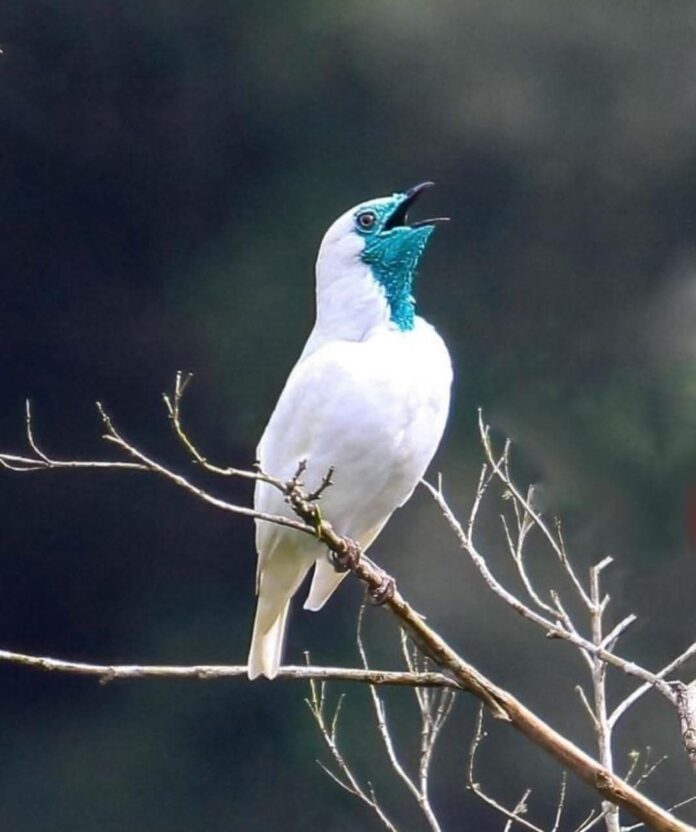
Scientific Name: Procnias Nudicollis
Bare-throated bellbird is a beautiful bellbird species, but only the males are gifted with the gorgeous look. Male bare-throated bellbirds have white plumage and bristly bluish-black skin around their eyes, beak, and throat. Females are rather plain, with olive-brown above and streaked yellow underparts. The females are around 27 centimeters long, while the males are slightly larger, measuring around 29 centimeters. They both have very wide gape,s which they use for feeding. Males make loud calls to attract a mate, usually from a high branch, and the breeding season is from September to February.
This bellbird species occurs in Argentina, Brazil, and Paraguay, where they live in moist subtropical and tropical forests. The natural habitats include primary forests, secondary forests, and subtropical and tropical moist montane forests where food is abundant. They feed only on fruit, they swallow the fruit whole, and then regurgitate large seeds. Unfortunately, this bellbird species is considered Near Threatened on the IUCN Red List due to collection for the pet bird trade and habitat loss. Humans heavily poach bare-throated bellbirds for cagebirds, and keeping them are cagebirds is very popular in Brazil. Agricultural conversion and deforestation affect their home greatly, and things are not getting better for them.
2Bearded Bellbird
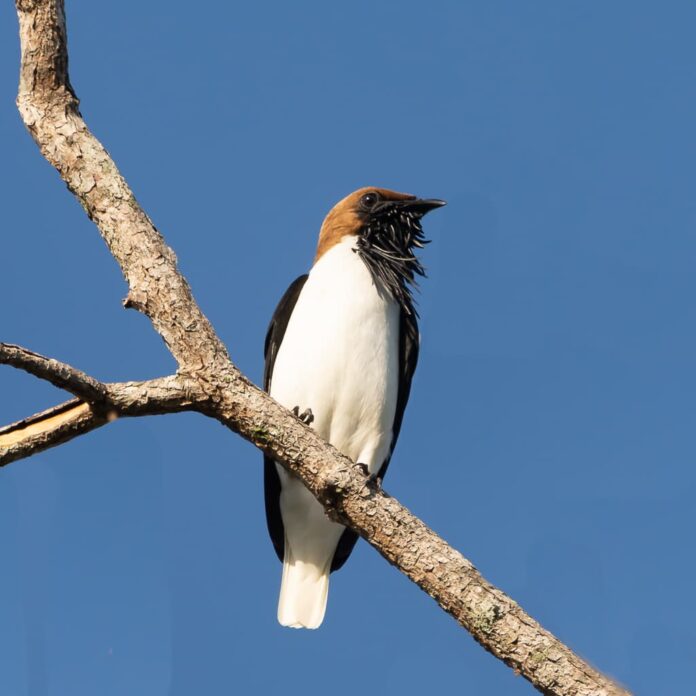
Scientific Name: Procnias Averano
The name says it all, a bearded bellbird looks like it has a beard under its beak. A male bearded bellbird has a white plumage, brown head, and black wings, and he is around 28 centimeters. The distinctive feature in a male is the several black unfeathered wattles that hang from his throat. Those black stringy wattles resemble a beard; hence the name. Just like other bellbird species out there, this one also makes very loud calls to attract mates and declare territories. As for the females, they are smaller, and they have olive-green upperparts and yellow underparts. This bellbird species occurs in northern South America, inhabiting moist tropical forests where it feeds mainly on berries and fruits. The population of this bird is good overall, but they are considered Vulnerable in Brazil. Some of the main threats are deforestation and trapping, which lead to the decline of their number.
3Three-Wattled Bellbird
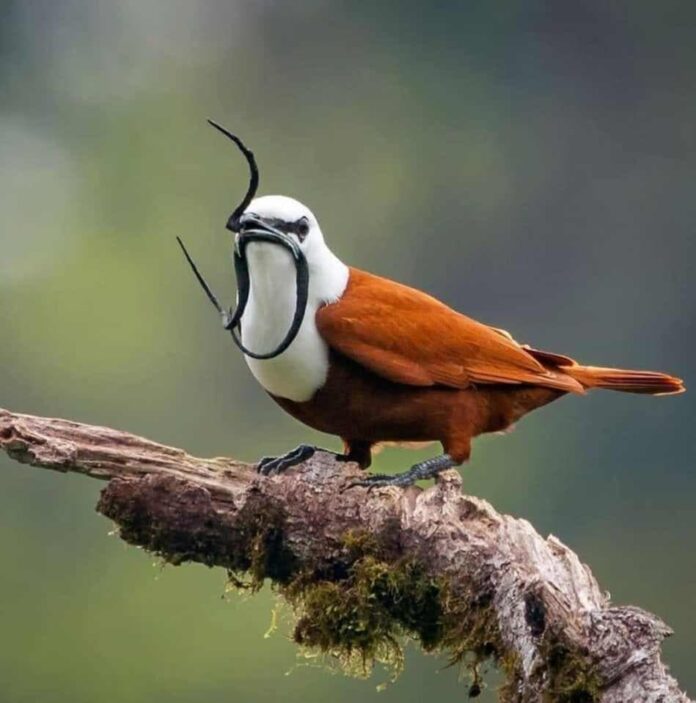
Scientific Name: Procnias Tricarunculata
Looking absolutely freaky, the three-wattled bellbirds are clearly one of a kind. A male three-wattled bellbird has a white head and throat, and the rest of the plumage is chestnut-brown. From the base of the beak, there are three long and slender black wattles dangling from each side of the mouth. These wattles can be as long as 10 centimeters when extended during interactions and songs. While projecting the calls, the males stretch open their gaping mouths and make their wattles quiver. Might not be attractive to us humans, but in the three-wattled bellbird world, the males need them to attract females. Speaking of females, they have olive plumage with yellowish streaked underparts, and they have no wattles.
The range of three-wattled bellbirds extends from Western Honduras all the way to Panama. Their habitats include subtropical and tropical moist lowlands, and subtropical and tropical moist montane. They breed in the highlands and migrate to the lowlands after the breeding season. Three-wattled bellbirds prefer the lowlands more because they are suited for crops. These birds are frugivorous, and their favorite food is wild avocados. The status of this bellbird species is Vulnerable due to habitat destruction and hunting.
4White Bellbird
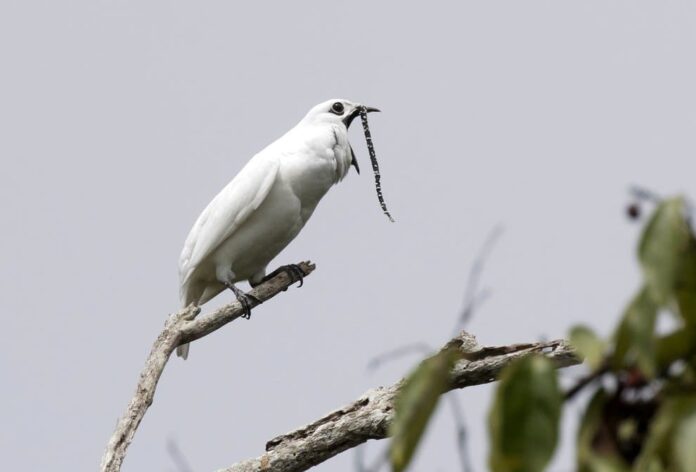
Scientific Name: Procnias Albus
Here you are looking at the loudest bird in the world, the white bellbird. Small but loud, a white bellbird only reaches 27 to 29 centimeters long. You can easily tell the male by the entirely white plumage, along with a single black wattle on its forehead. As for the female, she has an olive-green and yellow body and face, and the wattle is absent. Males have a wide mouth that opens broadly when they make calls or eat. A male white bellbird can make calls as loud as 125 dB, roughly as loud as a rock concert. This special loud call is simply to woo potential mates, and this is females cannot make loud calls.
Native to the Amazon rainforest, they are found in Brazil, French Guiana, Guyana, Suriname, and Venezuela, living in humid forests. Their habitats include lowland tropical and subtropical forest canopies, subtropical and tropical humid lowlands, and subtropical and tropical humid mountainous environments. White bellbirds love the canopy and edges at the tops of the humid Amazonian forest’s trees. These birds feed only on fruit such as berries by swallowing them whole, and then they regurgitate the seeds. Occasionally, when fruits are not abundant, this bellbird species also takes on a small number of insects. Their population is doing well, but the current threat is habitat loss from deforestation in its range.
Related Post: Birds With Beards

